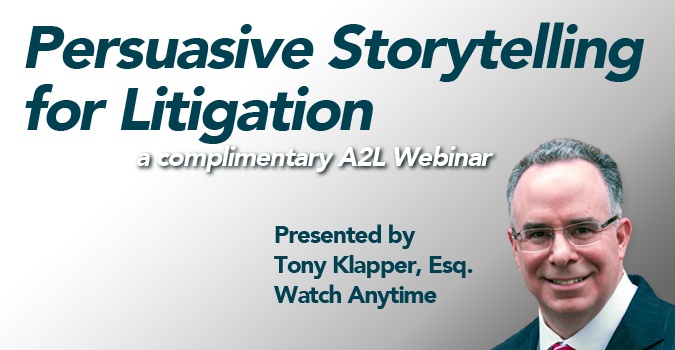by Tony Klapper
Managing Director, Litigation Consulting
A2L Consulting
We have written many times about the fact that scientific studies have shown that nonlawyers (who are the vast majority of jurors) tend to be visual learners, and tend not to be auditory learners or kinesthetic learners –people who learn by experiencing. Lawyers (who are the ones who present facts and tell stories to jurors) tend not to be visual learners and are often drawn from the ranks of auditory or kinesthetic learners.
Of course, this can present an intrinsic problem that we have discussed before. If most lawyers like to tell but not show, and our audience, the jury, prefers to be shown something and not to be told, we may completely fail to connect with our audience.
It’s not just psychologists and other students of human behavior who say so; it’s also people who devote full time to understanding trial advocacy. The National Institute of Trial Advocacy (NITA) is a fantastic organization that represents the “gold standard” of trial advocacy. In addition to putting on outstanding CLE programs for newbie and experienced litigators, NITA also publishes many great books from scholars who have thought long and hard about advocacy.
In a famous NITA publication, Modern Trial Advocacy, author Steven Lubet connects the obvious aspects of our daily lives with what we should be doing in the courtroom. He writes: “We are used to receiving our visual information from a screen . . . Why would any trial lawyer not want to provide jurors with the same graphic quality and medium that they experience in most other aspects of their lives?” Flip charts are fine, but carefully crafted litigation graphics might be better.
Another example comes from an ABA-published book recommended by NITA speakers and written by Steven Easton called, How to Win Jury Trials: Building Credibility with Judges and Jurors. Easton says something that may be obvious but still needs to be stated clearly. He writes, “We live in a picture-based society that is dominated not by words, but by television sets, video cameras, movie screens, computers and photo albums.” His implicit message? Don’t just tell, SHOW! It’s even more true now that so many people get their news from Facebook and turn to Instagram every day for photos.
Finally, there is this NITA-recommended example from a well-regarded trial advocacy scholar, Thomas Mauet, and his classic book, Trial Techniques: “Studies show that learning and retention are significantly better if information is communicated visually.” No question about it.
So we need go no further than NITA publications or those recommended by NITA, which for 40 years have helped countless lawyers understand how to try a case simply by doing it in simulated fashion. NITA and its writers and thinkers, top trial lawyers all, agree that showing rather than telling is the way to go.
Other A2L Consulting free articles and free learning resources about litigation graphics, jury psychology, trial advocacy, storytelling and demonstrative evidence include:
- 6 Studies That Support Litigation Graphics in Courtroom Presentations
- How to Get Great Results From a Good Lawyer
- Three Top Trial Lawyers Tell Us Why Storytelling Is So Important
- Announcing A2L’s New Storytelling Webinar
- Why You Should Pressure-Test Your Trial Graphics Well Before Trial
- Storytelling at Trial Works - But Whom Should the Story Be About?
- 7 Reasons a Fresh Pair of Eyes Are Beneficial Before Trial
- What Does A Case-Winning Trial Graphic Look Like?
- The Effective Use of PowerPoint Presentation During Opening Statement
- How Much Text on a PowerPoint Slide is Too Much?






Leave a Comment